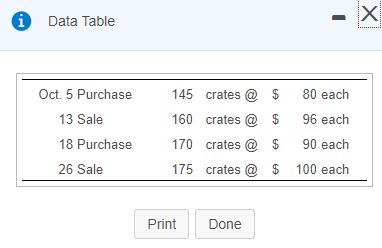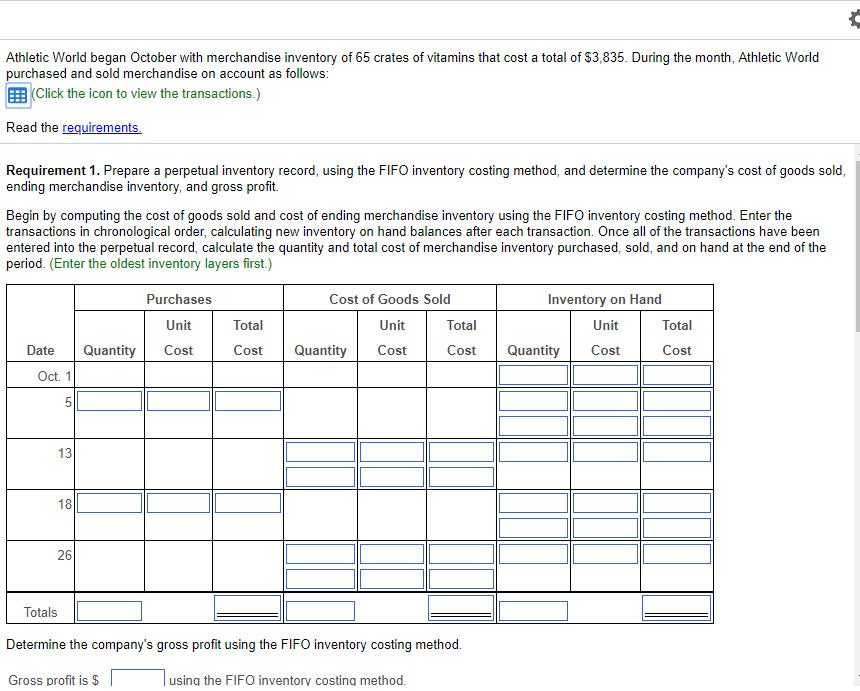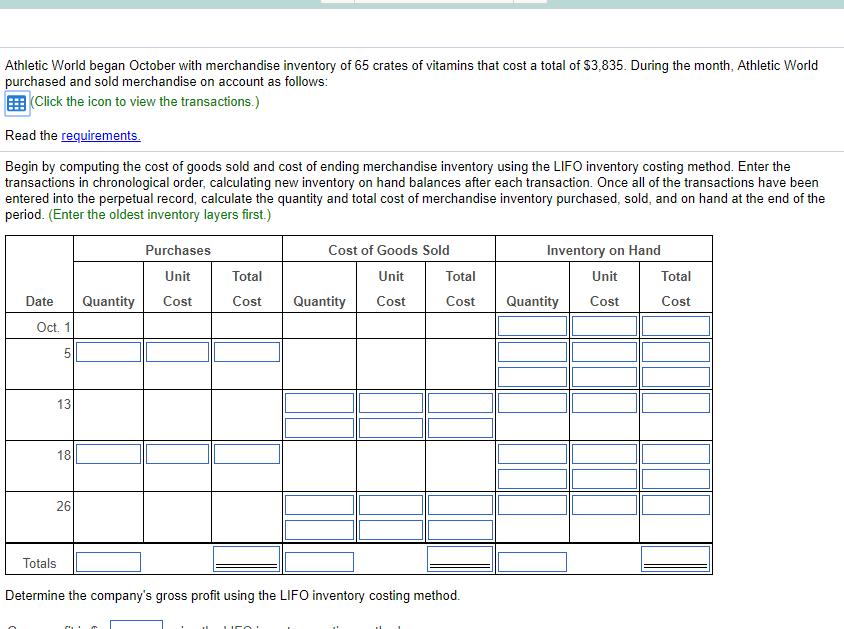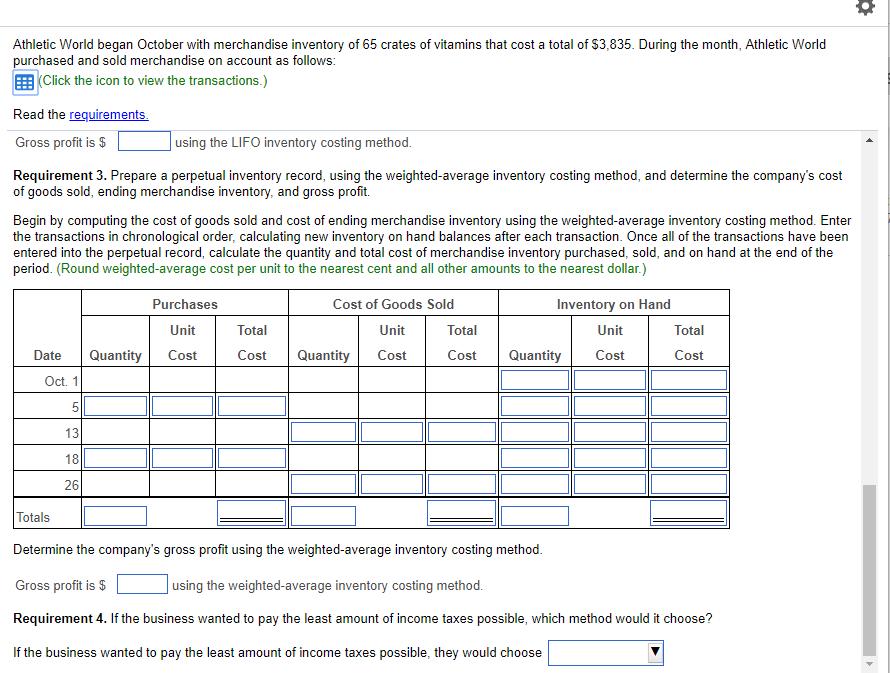Answered step by step
Verified Expert Solution
Question
1 Approved Answer
1. Prepare a perpetual inventory record, using the FIFO inventory costing method, and determine the company's cost of goods sold, ending merchandise inventory, and





1. Prepare a perpetual inventory record, using the FIFO inventory costing method, and determine the company's cost of goods sold, ending merchandise inventory, and gross profit. 2. Prepare a perpetual inventory record, using the LIFO inventory costing method, and determine the company's cost of goods sold, ending merchandise inventory, and gross profit. 3. Prepare a perpetual inventory record, using the weighted-average inventory costing method, and determine the company's cost of goods sold, ending merchandise inventory, and gross profit. (Round weighted-average cost per unit to the nearest cent and all other amounts to the nearest dollar.) If the business wanted to pay the least amount of income taxes possible, which method would it choose? Data Table - X Oct. 5 Purchase 145 crates @ $ 80 each 13 Sale 160 crates @$ 96 each 18 Purchase 170 crates @ $ 90 each 26 Sale 175 crates @ $ 100 each Print Done Athletic World began October with merchandise inventory of 65 crates of vitamins that cost a total of $3,835. During the month, Athletic World purchased and sold merchandise on account as follows: (Click the icon to view the transactions.) Read the requirements. Requirement 1. Prepare a perpetual inventory record, using the FIFO inventory costing method, and determine the company's cost of goods sold, ending merchandise inventory, and gross profit. Begin by computing the cost of goods sold and cost of ending merchandise inventory using the FIFO inventory costing method. Enter the transactions in chronological order, calculating new inventory on hand balances after each transaction. Once all of the transactions have been entered into the perpetual record, calculate the quantity and total cost of merchandise inventory purchased, sold, and on hand at the end of the period. (Enter the oldest inventory layers first.) Purchases Cost of Goods Sold Inventory on Hand Unit Total Unit Total Unit Total Date Quantity Cost Cost Quantity Cost Cost Quantity Cost Cost Oct. 1 13 18 26 Totals Determine the company's gross profit using the FIFO inventory costing method. Gross profit is $ using the FIFO inventory costing method. Athletic World began October with merchandise inventory of 65 crates of vitamins that cost a total of $3,835. During the month, Athletic World purchased and sold merchandise on account as follows: (Click the icon to view the transactions.) Read the requirements. Begin by computing the cost of goods sold and cost of ending merchandise inventory using the LIFO inventory costing method. Enter the transactions in chronological order, calculating new inventory on hand balances after each transaction. Once all of the transactions have been entered into the perpetual record, calculate the quantity and total cost of merchandise inventory purchased, sold, and on hand at the end of the period. (Enter the oldest inventory layers first.) Purchases Cost of Goods Sold Inventory on Hand Unit Total Unit Total Unit Total Date Quantity Cost Cost Quantity Cost Cost Quantity Cost Cost Oct. 1 13 18 26 Totals Determine the company's gross profit using the LIFO inventory costing method. Athletic World began October with merchandise inventory of 65 crates of vitamins that cost a total of $3,835. During the month, Athletic World purchased and sold merchandise on account as follows: (Click the icon to view the transactions.) Read the requirements. Gross profit is $ using the LIFO inventory costing method. Requirement 3. Prepare a perpetual inventory record, using the weighted-average inventory costing method, and determine the company's cost of goods sold, ending merchandise inventory, and gross profit. Begin by computing the cost of goods sold and cost of ending merchandise inventory using the weighted-average inventory costing method. Enter the transactions in chronological order, calculating new inventory on hand balances after each transaction. Once all of the transactions have been entered into the perpetual record, calculate the quantity and total cost of merchandise inventory purchased, sold, and on hand at the end of the period. (Round weighted-average cost per unit to the nearest cent and all other amounts to the nearest dollar.) Purchases Cost of Goods Sold Inventory on Hand Unit Total Unit Total Unit Total Date Quantity Cost Cost Quantity Cost Cost Quantity Cost Cost Oct. 1 5 13 18 26 Totals Determine the company's gross profit using the weighted-average inventory costing method. Gross profit is $ using the weighted-average inventory costing method. Requirement 4. If the business wanted to pay the least amount of income taxes possible, which method would it choose? If the business wanted to pay the least amount of income taxes possible, they would choose
Step by Step Solution
★★★★★
3.42 Rating (158 Votes )
There are 3 Steps involved in it
Step: 1
Requirement 1 Purchases Cost of goods sold Unit Cost Inventory on Hand Unit Cost Date Unit Cost Quan...
Get Instant Access to Expert-Tailored Solutions
See step-by-step solutions with expert insights and AI powered tools for academic success
Step: 2

Step: 3

Ace Your Homework with AI
Get the answers you need in no time with our AI-driven, step-by-step assistance
Get Started


